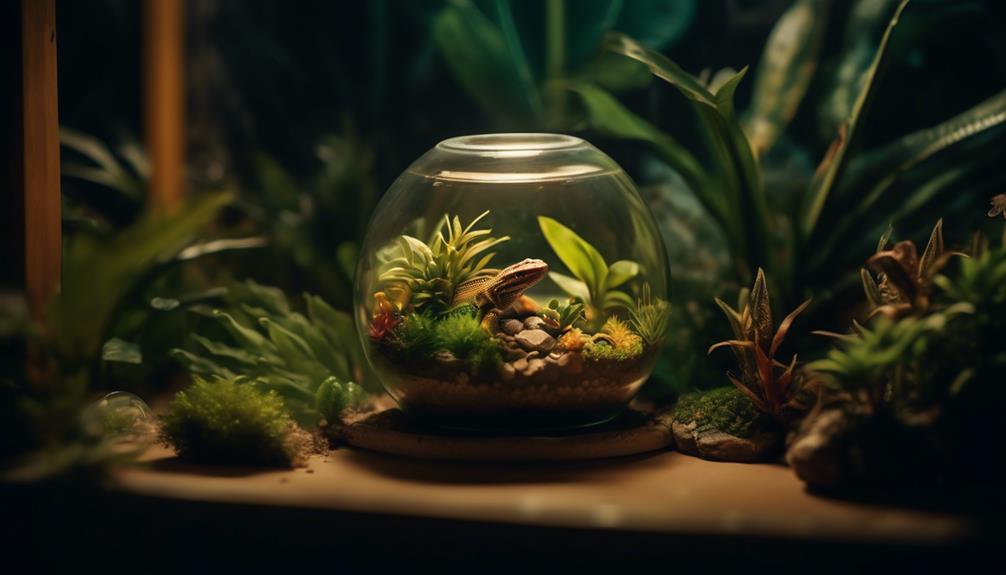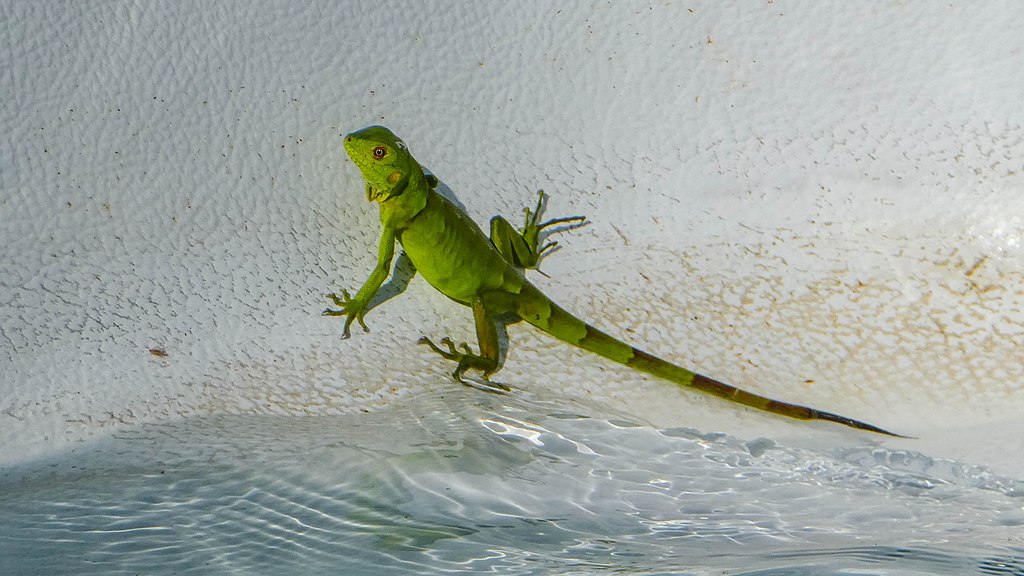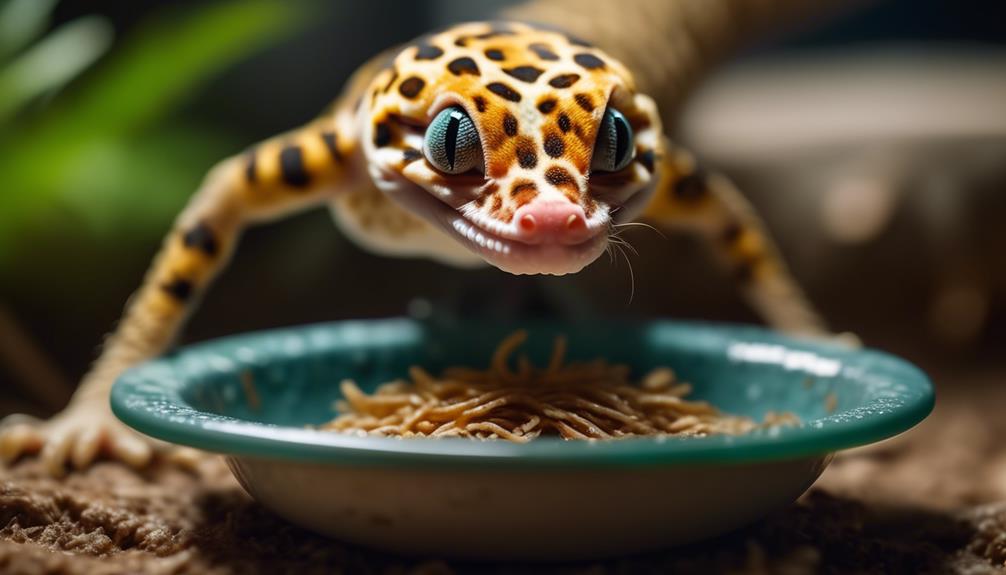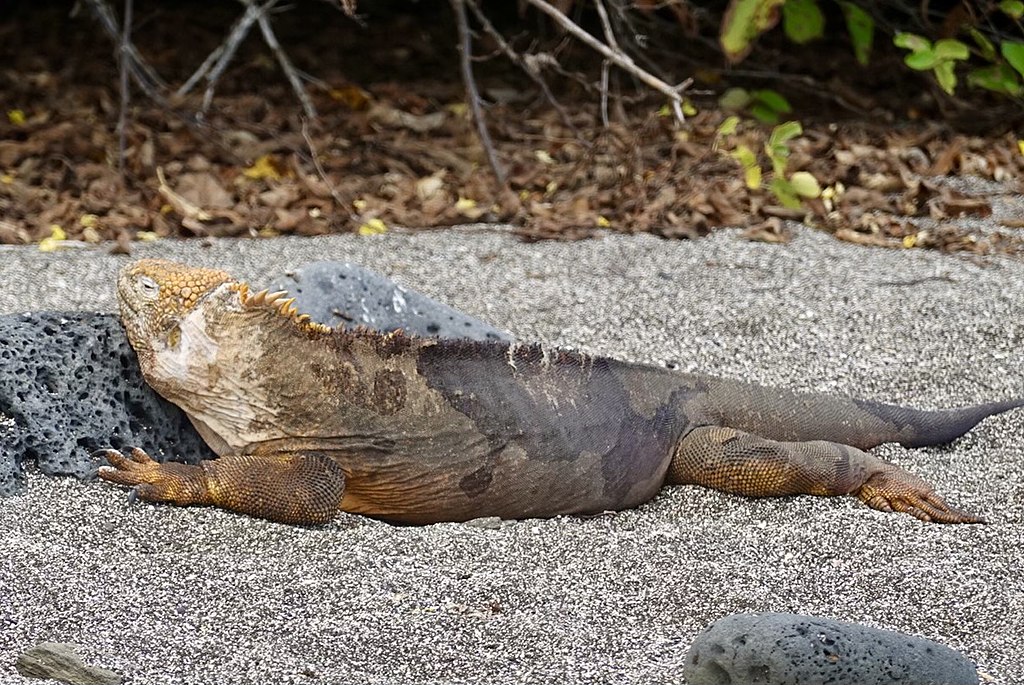Imagine walking into a lush rainforest, with the vibrant sounds of exotic birds and the warm sunlight filtering through the dense canopy above. It's a world teeming with life, where every creature has found its perfect niche.
Now, picture yourself as the architect of this vibrant ecosystem, responsible for creating the ideal environment for a unique species – fire skinks. How do you master the perfect habitat for these captivating creatures?
In this discussion, we will uncover the secrets to crafting a habitat that mirrors their natural home, ensuring their comfort, health, and overall well-being. Get ready to embark on an adventure into the world of fire skinks, where every detail matters and their thriving existence awaits.
Key Takeaways
- Fire skinks should be housed in a minimum 36 x 18 x 18 enclosure and providing a larger enclosure is beneficial for their activity level.
- Cohabitation is not recommended for fire skinks to prevent fighting and injuries.
- Fire skinks can survive without UVB lighting but thrive with it, as it provides a day/night cycle and vitamin D. Recommended UVB bulbs include Zoo Med Reptisun T5 HO 5.0 and Arcadia Desert 6%.
- Basking area temperature should be around 95°F, while the cooler area should stay between 75-85°F. Nighttime temperatures can drop to 65°F but not higher than 75°F. Halogen heat bulbs are recommended for heat source.
Housing Requirements
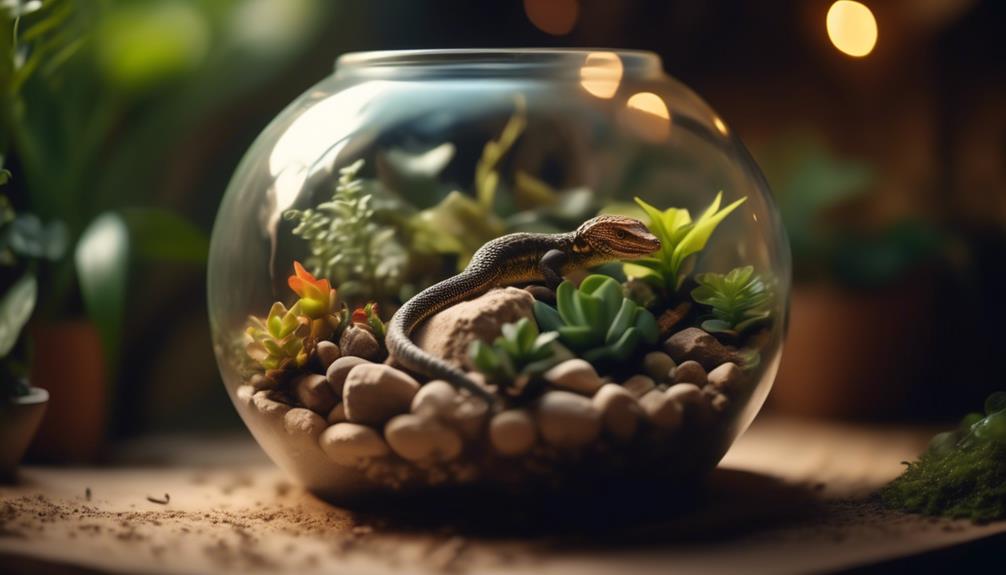
When housing fire skinks, it's essential to provide them with a minimum enclosure size of 36 x 18 x 18 inches, ensuring they've ample space for their activity level. This enclosure size allows for the skinks to move around comfortably, promoting natural behaviors and reducing stress.
Additionally, providing a larger enclosure is beneficial for their overall well-being. To create a suitable habitat, it's important to incorporate enclosure decorations that mimic their natural environment. This can include providing hiding spots such as rocks, logs, and vegetation.
Adding climbing areas, such as branches or vines, will also allow the skinks to exercise and explore their surroundings. These enclosure decorations not only enhance the aesthetic appeal but also provide mental stimulation and enrichment for the fire skinks.
UVB Lighting
UVB lighting plays a crucial role in the health and well-being of fire skinks. Proper installation and the use of the right types of UVB bulbs are essential for creating an optimal habitat for these reptiles. Here are three important points to consider:
- Proper installation: Ensure that the UVB bulb is placed on the basking side of the enclosure along with the heat lamp. This will allow the fire skinks to receive both heat and UVB light in the same area, mimicking their natural environment.
- Types of UVB bulbs: Consider using recommended UVB bulbs such as the Zoo Med Reptisun T5 HO 5.0 or the Arcadia Desert 6%. These bulbs provide the necessary UVB radiation that fire skinks need for their overall health and well-being.
- Additional daylight-spectrum lamp: It's also beneficial to use an additional daylight-spectrum lamp to provide bright illumination within the enclosure. This will create a more natural and visually appealing environment for the fire skinks.
Basking Temperature
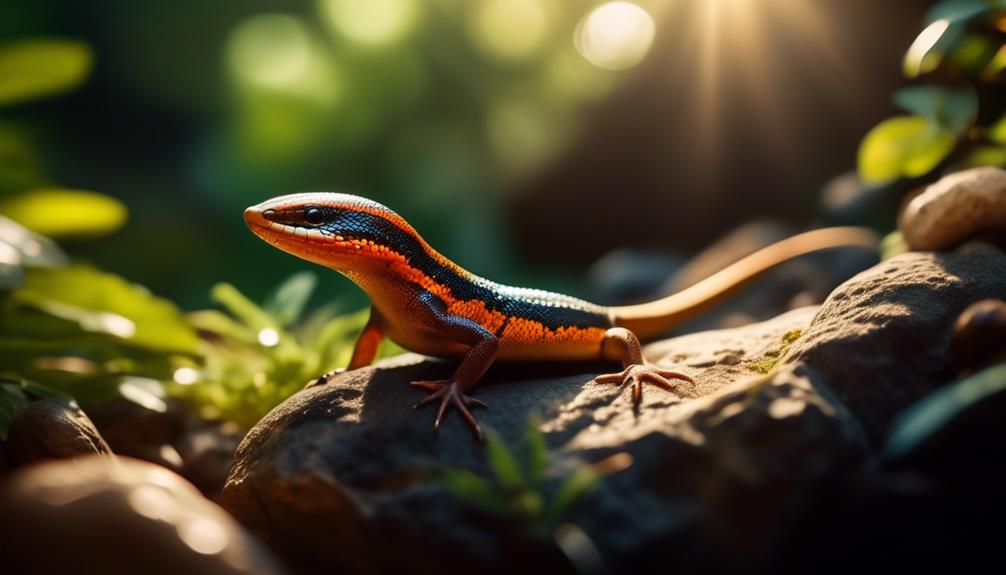
To create an optimal habitat for fire skinks, it's crucial to maintain the appropriate basking temperature within their enclosure. Basking temperature refers to the temperature range at which fire skinks regulate their body temperature.
The optimal range for the basking area is around 95°F, while the cooler area should stay between 75-85°F. It's important to note that the nighttime temperatures can drop to 65°F, but shouldn't exceed 75°F.
Accurate measurement of the basking temperature can be achieved using a digital probe thermometer. For heat sources, it's recommended to use halogen heat bulbs, while avoiding ceramic heat emitters or heat mats.
Humidity Levels
Maintaining appropriate humidity levels is crucial for creating an optimal habitat for fire skinks and ensuring their health and well-being. Fire skinks require a humidity level between 60-70% during the day, with higher levels at night. To achieve this, it's important to have proper humidity control in their enclosure.
Here are three key factors to consider for maintaining humidity levels and preventing dehydration in fire skinks:
- Measure humidity with a digital probe hygrometer: Regularly monitor the humidity levels in the enclosure to ensure they're within the desired range. This will help you make necessary adjustments to maintain optimal humidity for your fire skinks.
- Mist the enclosure 1-2 times a day: Mist the enclosure with water to increase and maintain humidity levels. This will provide the necessary moisture for the skinks and prevent dehydration.
- Provide a humid hideout: Create a humid hideout within the enclosure by lining it with moistened substrate or sphagnum moss. This will give the skinks a designated area with higher humidity, allowing them to regulate their moisture levels and prevent dehydration.
Substrate Options
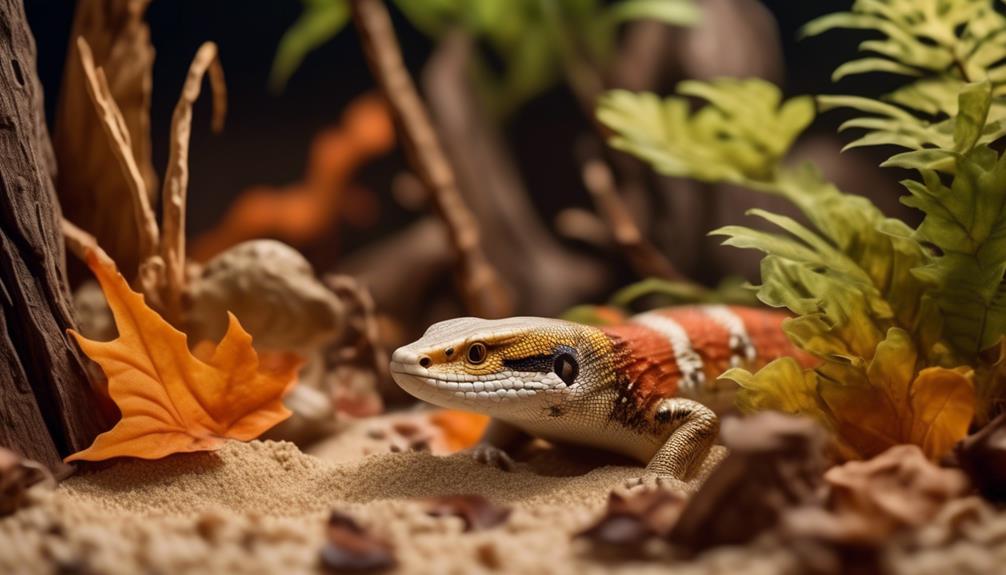
When selecting a substrate for fire skinks, it's important to choose one that imitates tropical soil and provides the necessary conditions for their well-being and natural behaviors. Recommended substrates for fire skinks include Zoo Med Eco Earth, Zoo Med ReptiSoil, Exo Terra Plantation Soil, and Zilla Jungle Mix. These substrates have the advantage of mimicking the natural habitat of fire skinks, promoting their burrowing and foraging instincts. They also retain moisture well, helping to maintain the required humidity levels.
To maintain substrate cleanliness, it's best to replace the substrate every 3-4 months. Additionally, removing waste and contaminated substrate on a daily basis is crucial. Adding clean leaf litter on top of the substrate provides enrichment and helps to maintain humidity levels.
Frequently Asked Questions
Can Fire Skinks Be Housed With Other Reptiles or Animals?
Fire skinks should not be housed with other reptiles or animals to prevent fighting and injuries. They require a minimum 36 x 18 x 18 enclosure with appropriate hiding spots and climbing areas.
Are There Any Specific Plants or Decorations That Should Be Included in the Fire Skink's Enclosure?
Including a variety of live plants, such as bromeliads and pothos, can enhance the fire skink's enclosure. Decorations like rocks, branches, and cork bark provide important hiding spots and climbing areas for these reptiles.
How Often Should the UVB Bulb and Heat Lamp Be Replaced?
When should you replace the UVB bulb and heat lamp for fire skinks, and what are the signs? It is recommended to replace the UVB bulb every 6-12 months and the heat lamp every 6-9 months to ensure optimal light and heat output. Signs of needing replacement include diminished light or heat.
What Type of Water Source Should Be Provided for Fire Skinks?
Fire skinks prefer a water dish large enough for soaking. Adequate humidity is crucial for their health, as it helps with shedding and respiratory function. Mist the enclosure and provide a humid hideout to maintain humidity.
Can Fire Skinks Be Handled or Are They Strictly Display Pets?
Fire skinks can be handled, but they are primarily display pets. When handling, support their body and avoid excessive stress. Alternative habitats for fire skinks include bioactive setups with live plants and naturalistic environments.
Conclusion
In conclusion, with the knowledge gained from this article, you're well-equipped to create the ultimate habitat for your fire skinks.
Their housing requirements, UVB lighting, basking temperature, humidity levels, and substrate options have all been thoroughly explored.
By implementing these essential elements, you'll provide your fire skinks with a comfortable and thriving environment.
So go forth and create the perfect habitat for these incredible creatures, and watch them flourish in their new home!
